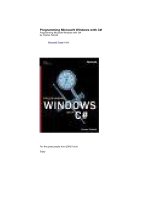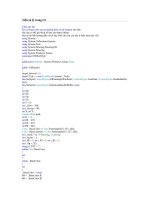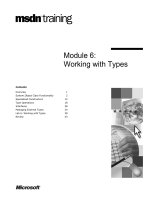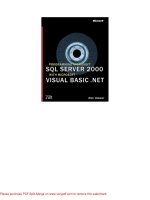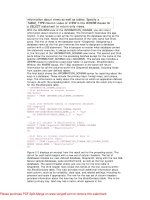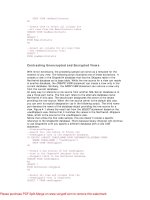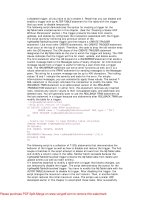Tài liệu Programming Microsoft Windows with C# pptx
Bạn đang xem bản rút gọn của tài liệu. Xem và tải ngay bản đầy đủ của tài liệu tại đây (7.73 MB, 1,073 trang )
Programming Microsoft Windows with C#
Programming Microsoft Windows with C#
by Charles Petzold
Microsoft Press © 2002
For the great people from [OR] Forum
Enjoy
Programming Microsoft Windows with C#
Charles Petzold
PUBLISHED BY
Microsoft Press
A Division of Microsoft Corporation
One Microsoft Way
Redmond, Washington 98052-6399
Copyright © 2002 by Charles Petzold
All rights reserved. No part of the contents of this book may be reproduced or transmitted in any form
or by any means without the written permission of the publisher.
Library of Congress Cataloging-in-Publication Data
Petzold, Charles, 1953-
Programming Microsoft Windows with C# / Charles Petzold.
p. cm.
Includes index.
ISBN 0-7356-1370-2
1. C# (Computer program language) 2. Microsoft Windows (Computer file) I. Title.
QA76.73.C154 P48 2001
005.26'8--dc21
2001052178
1 2 3 4 5 6 7 8 9 QWT 7 6 5 4 3 2
Distributed in Canada by Penguin Books Canada Limited.
A CIP catalogue record for this book is available from the British Library.
Microsoft Press books are available through booksellers and distributors worldwide. For further
information about international editions, contact your local Microsoft Corporation office or contact
Microsoft Press International directly at fax (425) 936-7329. Visit our Web site at
www.microsoft.com/mspress. Send comments to
ClearType, Georgia, IntelliMouse, Microsoft, Microsoft Press, MS-DOS, MSDN, Natural, the .NET
logo, OpenType, Verdana, Visual Basic, Visual C#, Visual Studio, Webdings, Win32, Windows,
Windows NT, and Wingdings are either registered trademarks or trademarks of Microsoft
Corporation in the United States and/or other countries. Other product and company names
mentioned herein may be the trademarks of their respective owners.
The example companies, organizations, products, domain names, e-mail addresses, logos, people,
places, and events depicted herein are fictitious. No association with any real company,
organization, product, domain name, e-mail address, logo, person, place, or event is intended or
should be inferred.
Acquisitions Editor: Danielle Bird
Project Editor:
Sally Stickney
Technical Editor: Jean Ross
Body Part No. X08-22413
About The Author
Charles Petzold
Charles Petzold (www.charlespetzold.com) is a full-time freelance writer who has been programming
for Microsoft Windows since 1985 and writing about Windows programming for nearly as long. He
wrote the very first magazine article about Windows programming for the December 1986 issue of
Microsoft Systems Journal. His book Programming Windows (first published by Microsoft Press in
1988 and currently in its fifth edition) taught a generation of programmers how to write applications
for Windows. In May 1994, Petzold was one of only seven people (and the only writer) to be given a
Windows Pioneer Award from Windows Magazine and Microsoft Corporation for his contribution to
the success of Microsoft Windows. He is also the author of a unique introduction to the inner
workings of computers entitled Code: The Hidden Language of Computer Hardware and Software.
Petzold is currently researching a book on the historical origins of software.
The manuscript for this book was prepared and galleyed using Microsoft Word version 2000. Pages
were composed by Microsoft Press using Adobe PageMaker 6.52 for Windows, with text in
Garamond and display type in Helvetica Condensed. Composed pages were delivered to the printer
as electronic prepress files.
Cover Designer:
Methodologie, Inc.
Interior Graphic Designer:
James D. Kramer
Principal Compositor:
Paula Gorelick
Interior Artist:
Joel Panchot
Principal Copy Editor:
Holly M. Viola
Indexer: Shane-Armstrong Information Systems
PROGRAMMING MICROSOFT WINDOWS WITH C#..........2
WINDOWS PROGRAMMING: AN OVERVIEW....................................................................14
USER REQUIREMENTS.........................................................................................................15
S
YSTEM
R
EQUIREMENTS
....................................................................................................16
THE ORGANIZATION OF THIS BOOK.................................................................................16
THE CD-ROM
.......................................................................................................................17
SUPPORT................................................................................................................................17
SPECIAL THANKS
..................................................................................................................17
CHAPTER 1: CONSOLE THYSELF......................................................19
OVERVIEW ..............................................................................................................................19
THE C# VERSION
..................................................................................................................19
ANATOMY OF A PROGRAM..................................................................................................21
C# NAMESPACES
.................................................................................................................22
CONSOLE I/O.........................................................................................................................23
C# DATA TYPES....................................................................................................................25
EXPRESSIONS AND OPERATORS ......................................................................................29
CONDITIONS AND ITERATIONS...........................................................................................31
T
HE
L
EAP TO
O
BJECTS
.......................................................................................................34
PROGRAMMING IN THE KEY OF C#...................................................................................38
STATIC METHODS
.................................................................................................................40
EXCEPTION HANDLING........................................................................................................41
THROWING EXCEPTIONS
....................................................................................................43
GETTING AND SETTING PROPERTIES..............................................................................44
CONSTRUCTORS
...................................................................................................................47
INSTANCES AND INHERITANCE ..........................................................................................51
A BIGGER PICTURE..............................................................................................................54
NAMING CONVENTIONS.......................................................................................................55
BEYOND THE CONSOLE.......................................................................................................56
CHAPTER 2: HELLO, WINDOWS FORMS ...................................57
OVERVIEW ..............................................................................................................................57
THE MESSAGE BOX..............................................................................................................58
THE FORM ..............................................................................................................................63
SHOWING THE FORM ...........................................................................................................64
I
T
'
S AN
A
PPLICATION AND
W
E
W
ANT TO
R
UN
I
T
...........................................................66
VARIATIONS ON A THEME ...................................................................................................68
FORM PROPERTIES
..............................................................................................................68
EVENT-DRIVEN INPUT..........................................................................................................70
HANDLING THE PAINT EVENT
............................................................................................71
DISPLAYING TEXT.................................................................................................................74
The Font...............................................................................................................................74
The Brush............................................................................................................................75
The Coordinate Points.......................................................................................................75
THE PAINT EVENT IS SPECIAL!
.........................................................................................78
MULTIPLE FORMS, MULTIPLE HANDLERS ......................................................................78
INHERITING FORMS
..............................................................................................................80
THE ONPAINT METHOD.......................................................................................................82
DOES MAIN BELONG HERE? .............................................................................................83
EVENTS AND "ON" METHODS............................................................................................85
CHAPTER 3: ESSENTIAL STRUCTURES ....................................89
OVERVIEW ..............................................................................................................................89
CLASSES AND STRUCTURES..............................................................................................89
TWO-DIMENSIONAL COORDINATE POINTS.....................................................................90
A
RRAYS OF
P
OINTS
..............................................................................................................92
THE SIZE STRUCTURE.........................................................................................................92
T
HE
F
LOAT
V
ERSIONS
.........................................................................................................93
A RECTANGLE IS A POINT AND A SIZE ............................................................................95
RECTANGLE PROPERTIES AND METHODS
.....................................................................96
A NICE-SIZED FORM............................................................................................................98
THE FORM AND THE CLIENT
...............................................................................................99
POINT CONVERSIONS........................................................................................................102
THE COLOR STRUCTURE..................................................................................................103
THE 141 COLOR NAMES...................................................................................................104
PENS AND BRUSHES..........................................................................................................104
S
YSTEM
C
OLORS
................................................................................................................106
THE KNOWN COLORS........................................................................................................108
W
HAT TO
U
SE
?...................................................................................................................109
GETTING A FEEL FOR REPAINTS.....................................................................................109
CENTERING HELLO WORLD
.............................................................................................112
MEASURING THE STRING..................................................................................................115
TEXT IN A RECTANGLE
......................................................................................................117
CHAPTER 4: AN EXERCISE IN TEXT OUTPUT ...................120
OVERVIEW ............................................................................................................................120
SYSTEM INFORMATION
......................................................................................................120
SPACING LINES OF TEXT ..................................................................................................120
PROPERTY VALUES............................................................................................................121
FORMATTING INTO COLUMNS..........................................................................................123
EVERYTHING IS AN OBJECT .............................................................................................125
L
ISTING THE
S
YSTEM
I
NFORMATION
..............................................................................130
WINDOWS FORMS AND SCROLL BARS..........................................................................132
SCROLLING A PANEL CONTROL
......................................................................................132
THE HERITAGE OF SCROLLABLECONTROL..................................................................136
SCROLLING WITHOUT CONTROLS
..................................................................................136
ACTUAL NUMBERS..............................................................................................................138
DON'T BE A PIG
...................................................................................................................141
REFLECTING ON THE FUTURE .........................................................................................142
CHAPTER 5: LINES, CURVES, AND AREA FILLS
...........149
OVERVIEW
............................................................................................................................149
HOW TO GET A GRAPHICS OBJECT ...............................................................................149
PENS, BRIEFLY
....................................................................................................................150
STRAIGHT LINES .................................................................................................................151
AN INTRODUCTION TO PRINTING ....................................................................................152
PROPERTIES AND STATE..................................................................................................157
ANTI-ALIASING.....................................................................................................................158
M
ULTIPLE
C
ONNECTED
L
INES
.........................................................................................160
CURVES AND PARAMETRIC EQUATIONS.......................................................................164
T
HE
U
BIQUITOUS
R
ECTANGLE
........................................................................................167
GENERALIZED POLYGONS................................................................................................169
EASIER ELLIPSES
................................................................................................................170
ARCS AND PIES...................................................................................................................171
FILLING RECTANGLES, ELLIPSES, AND PIES
...............................................................177
OFF BY 1...............................................................................................................................178
POLYGONS AND THE FILLING MODE ..............................................................................180
CHAPTER 6: TAPPING INTO THE KEYBOARD ..................184
OVERVIEW ............................................................................................................................184
IGNORING THE KEYBOARD ...............................................................................................184
WHO'S GOT THE FOCUS?.................................................................................................184
KEYS AND CHARACTERS...................................................................................................185
K
EYS
D
OWN AND
K
EYS
U
P
..............................................................................................186
THE KEYS ENUMERATION.................................................................................................187
T
ESTING THE
M
ODIFIER
K
EYS
.........................................................................................194
REALITY CHECK..................................................................................................................195
A KEYBOARD INTERFACE FOR SYSINFO
.......................................................................196
KEYPRESS FOR CHARACTERS........................................................................................197
CONTROL CHARACTERS
...................................................................................................198
LOOKING AT THE KEYS......................................................................................................199
INVOKING THE WIN32 API................................................................................................203
HANDLING INPUT FROM FOREIGN KEYBOARDS ..........................................................205
INPUT FOCUS.......................................................................................................................207
T
HE
M
ISSING
C
ARET
.........................................................................................................208
ECHOING KEY CHARACTERS...........................................................................................212
R
IGHT
-
TO
-L
EFT
P
ROBLEMS
.............................................................................................216
CHAPTER 7: PAGES AND TRANSFORMS ...............................218
OVERVIEW ............................................................................................................................218
DEVICE INDEPENDENCE THROUGH TEXT
.....................................................................218
HOW MUCH IS THAT IN REAL MONEY?.........................................................................218
DOTS PER INCH
..................................................................................................................220
WHAT'S WITH THE PRINTER?...........................................................................................221
MANUAL CONVERSIONS
....................................................................................................222
PAGE UNITS AND PAGE SCALE.......................................................................................225
PEN WIDTHS........................................................................................................................228
PAGE TRANSFORMS...........................................................................................................231
SAVING THE GRAPHICS STATE
........................................................................................232
METRICAL DIMENSIONS ....................................................................................................233
ARBITRARY COORDINATES
..............................................................................................237
WHAT YOU CAN'T DO........................................................................................................239
HELLO, WORLD TRANSFORM ..........................................................................................240
THE BIG PICTURE...............................................................................................................244
LINEAR TRANSFORMS........................................................................................................244
I
NTRODUCING
M
ATRIXES
..................................................................................................246
THE MATRIX CLASS ...........................................................................................................248
S
HEAR AND
S
HEAR
A
LIKE
................................................................................................250
COMBINING TRANSFORMS................................................................................................252
CHAPTER 8: TAMING THE MOUSE..................................................254
O
VERVIEW
............................................................................................................................254
THE DARK SIDE OF THE MOUSE.....................................................................................254
IGNORING THE MOUSE
......................................................................................................255
SOME QUICK DEFINITIONS...............................................................................................255
INFORMATION ABOUT THE MOUSE
.................................................................................255
THE MOUSE WHEEL...........................................................................................................256
THE FOUR BASIC MOUSE EVENTS.................................................................................257
DOING THE WHEEL.............................................................................................................259
MOUSE MOVEMENT ...........................................................................................................262
T
RACKING AND
C
APTURING THE
M
OUSE
......................................................................264
ADVENTURES IN TRACKING..............................................................................................267
G
ENERALIZING
C
ODE WITH
I
NTERFACES
.....................................................................274
CLICKS AND DOUBLE-CLICKS..........................................................................................277
MOUSE-RELATED PROPERTIES
......................................................................................278
ENTERING, LEAVING, HOVERING ...................................................................................279
THE MOUSE CURSOR
........................................................................................................280
AN EXERCISE IN HIT-TESTING.........................................................................................287
ADDING A KEYBOARD INTERFACE ..................................................................................289
PUTTING THE CHILDREN TO WORK................................................................................291
HIT-TESTING TEXT .............................................................................................................296
S
CRIBBLING WITH THE
M
OUSE
........................................................................................297
CHAPTER 9: TEXT AND FONTS...........................................................303
OVERVIEW ............................................................................................................................303
F
ONTS
U
NDER
W
INDOWS
.................................................................................................303
TALKING TYPE .....................................................................................................................303
FONT HEIGHTS AND LINE SPACING
................................................................................305
DEFAULT FONTS.................................................................................................................306
VARIATION ON A FONT
.......................................................................................................306
CREATING FONTS BY NAME.............................................................................................309
A POINT SIZE BY ANY OTHER NAME…
.........................................................................313
CLASH OF THE UNITS.........................................................................................................317
FONT PROPERTIES AND METHODS................................................................................319
NEW FONTS FROM FONTFAMILY ....................................................................................324
UNDERSTANDING THE DESIGN METRICS
......................................................................326
ARRAYS OF FONT FAMILIES.............................................................................................329
FONT COLLECTIONS
...........................................................................................................335
VARIATIONS ON DRAWSTRING........................................................................................336
ANTI-ALIASED TEXT...........................................................................................................337
MEASURING THE STRING..................................................................................................339
THE STRINGFORMAT OPTIONS.......................................................................................340
G
RID
F
ITTING AND
T
EXT
F
ITTING
...................................................................................341
HORIZONTAL AND VERTICAL ALIGNMENT.....................................................................343
T
HE
H
OTKEY
D
ISPLAY
.......................................................................................................348
A CLIP AND A TRIM.............................................................................................................349
START A TAB
........................................................................................................................356
CHAPTER 10: THE TIMER AND TIME ............................................363
OVERVIEW ............................................................................................................................363
THE TIMER CLASS
..............................................................................................................363
THE DATETIME STRUCTURE............................................................................................366
LOCAL TIME AND UNIVERSAL TIME
................................................................................368
THE TICK COUNT................................................................................................................370
CALENDARS AROUND THE WORLD ................................................................................372
A READABLE RENDITION ..................................................................................................374
A SIMPLE CULTURE-SPECIFIC CLOCK..........................................................................378
T
HE
R
ETRO
L
OOK
...............................................................................................................383
AN ANALOG CLOCK............................................................................................................388
A
L
ITTLE
P
UZZLE
C
ALLED
J
EU DE
T
AQUIN
...................................................................394
CHAPTER 11: IMAGES AND BITMAPS ........................................401
OVERVIEW ............................................................................................................................401
BITMAP SUPPORT OVERVIEW
..........................................................................................402
BITMAP FILE FORMATS......................................................................................................402
LOADING AND DRAWING
...................................................................................................405
IMAGE INFORMATION..........................................................................................................409
RENDERING THE IMAGE
.....................................................................................................413
FITTING TO A RECTANGLE................................................................................................415
ROTATE AND SHEAR..........................................................................................................420
DISPLAYING PART OF THE IMAGE...................................................................................421
DRAWING ON THE IMAGE ..................................................................................................426
M
ORE ON THE
I
MAGE
C
LASS
...........................................................................................430
THE BITMAP CLASS............................................................................................................433
HELLO WORLD WITH A BITMAP
.......................................................................................435
THE SHADOW BITMAP .......................................................................................................437
BINARY RESOURCES
.........................................................................................................439
ANIMATION............................................................................................................................443
THE IMAGE LIST
..................................................................................................................449
THE PICTURE BOX..............................................................................................................452
CHAPTER 12: BUTTONS AND LABELS AND SCROLLS
(OH MY!)
...........................................................................................................................456
OVERVIEW
............................................................................................................................456
BUTTONS AND CLICKS.......................................................................................................456
KEYBOARD AND MOUSE
....................................................................................................459
CONTROL ISSUES ...............................................................................................................460
DEEPER INTO BUTTONS....................................................................................................460
APPEARANCE AND ALIGNMENT.......................................................................................464
BUTTONS WITH BITMAPS ..................................................................................................466
M
ULTIPLE
H
ANDLERS OR
O
NE
?......................................................................................469
DRAWING YOUR OWN BUTTONS....................................................................................469
DROPPING ANCHOR
...........................................................................................................474
DOCK AROUND THE CLOCK .............................................................................................477
CHILDREN OF THE FORM
..................................................................................................480
Z-ORDER ..............................................................................................................................482
THE CHECK BOX.................................................................................................................482
THE THREE-STATE ALTERNATIVE ..................................................................................486
THE LABEL CONTROL........................................................................................................486
TAB STOPS AND TAB ORDER...........................................................................................489
IDENTIFYING THE CONTROLS...........................................................................................489
T
HE
A
UTO
-S
CALE
O
PTION
...............................................................................................492
How the Windows Forms Designer Uses Auto-Scale................................................493
Creative AutoScaleBaseSize Settings..........................................................................493
Inside Auto-Scale.............................................................................................................494
A HEXADECIMAL CALCULATOR.......................................................................................496
RADIO BUTTONS AND GROUP BOXES...........................................................................501
SCROLL BARS......................................................................................................................504
THE TRACK BAR ALTERNATIVE.......................................................................................511
CHAPTER 13: BÉZIERS AND OTHER SPLINES.................516
OVERVIEW ............................................................................................................................516
THE BÉZIER SPLINE IN PRACTICE ..................................................................................516
A MORE STYLISH CLOCK .................................................................................................520
COLLINEAR BÉZIERS..........................................................................................................523
C
IRCLES AND
A
RCS WITH
B
ÉZIERS
................................................................................525
BÉZIER ART..........................................................................................................................528
THE MATHEMATICAL DERIVATION
..................................................................................529
THE CANONICAL SPLINE...................................................................................................533
CANONICAL CURVE DERIVATION
....................................................................................539
CHAPTER 14: MENUS......................................................................................543
OVERVIEW ............................................................................................................................543
MENUS AND MENU ITEMS
.................................................................................................543
MENU SHORTCUT KEYS....................................................................................................545
YOUR FIRST MENU
.............................................................................................................547
UNCONVENTIONAL MENUS...............................................................................................550
MENUITEM PROPERTIES AND EVENTS
..........................................................................552
CHECKING THE ITEMS........................................................................................................554
WORKING WITH CONTEXT MENUS
.................................................................................557
THE MENU ITEM COLLECTION.........................................................................................561
THE STANDARD MENU (A PROPOSAL) .........................................................................565
THE OWNER-DRAW OPTION............................................................................................570
CHAPTER 15: PATHS, REGIONS, AND CLIPPING..........580
OVERVIEW ............................................................................................................................580
A PROBLEM AND ITS SOLUTION......................................................................................580
THE PATH, MORE FORMALLY..........................................................................................584
C
REATING THE
P
ATH
.........................................................................................................586
RENDERING THE PATH ......................................................................................................589
P
ATH
T
RANSFORMS
...........................................................................................................593
OTHER PATH MODIFICATIONS.........................................................................................595
CLIPPING WITH PATHS
.......................................................................................................602
CLIPPING BITMAPS.............................................................................................................607
REGIONS AND CLIPPING
...................................................................................................610
CHAPTER 16: DIALOG BOXES .............................................................613
OVERVIEW ............................................................................................................................613
YOUR FIRST MODAL DIALOG BOX
..................................................................................613
MODAL DIALOG BOX TERMINATION...............................................................................617
ACCEPT AND CANCEL........................................................................................................619
SCREEN LOCATION ............................................................................................................621
THE ABOUT BOX.................................................................................................................623
D
EFINING
P
ROPERTIES IN
D
IALOG
B
OXES
...................................................................626
IMPLEMENTING AN APPLY BUTTON ................................................................................632
THE MODELESS DIALOG BOX
..........................................................................................635
THE COMMON DIALOG BOXES ........................................................................................639
CHOOSING FONTS AND COLORS
....................................................................................639
USING THE WINDOWS REGISTRY ...................................................................................646
THE OPEN FILE DIALOG BOX
...........................................................................................650
THE SAVE FILE DIALOG BOX ...........................................................................................657
CHAPTER 17: BRUSHES AND PENS
.............................................660
OVERVIEW
............................................................................................................................660
FILLING IN SOLID COLORS................................................................................................660
HATCH BRUSHES................................................................................................................661
THE RENDERING ORIGIN ..................................................................................................669
TEXTURE BRUSHES............................................................................................................672
LINEAR GRADIENT BRUSHES...........................................................................................677
PATH GRADIENT BRUSHES..............................................................................................685
T
ILING THE
B
RUSH
.............................................................................................................690
PENS CAN BE BRUSHES TOO .........................................................................................699
A DASH OF STYLE
..............................................................................................................702
CAPS AND JOINS
.................................................................................................................704
CHAPTER 18: EDIT, LIST, AND SPIN..............................................712
OVERVIEW ............................................................................................................................712
SINGLE-LINE TEXT BOXES
...............................................................................................712
MULTILINE TEXT BOXES....................................................................................................716
CLONING NOTEPAD
............................................................................................................717
THE NOTEPAD CLONE WITH FILE I/O ............................................................................722
NOTEPAD CLONE CONTINUED.........................................................................................732
SPECIAL-PURPOSE TEXT BOXES ...................................................................................748
THE RICH TEXT BOX..........................................................................................................749
T
OOL
T
IPS
.............................................................................................................................750
THE LIST BOX......................................................................................................................757
L
IST
B
OX
+ T
EXT
B
OX
= C
OMBO
B
OX
..........................................................................762
UP-DOWN CONTROLS.......................................................................................................768
CHAPTER 19: FONT FUN .............................................................................780
O
VERVIEW
............................................................................................................................780
GETTING STARTED.............................................................................................................780
BRUSHED TEXT
...................................................................................................................782
FONT TRANSFORMS...........................................................................................................788
TEXT AND PATHS
................................................................................................................799
NONLINEAR TRANSFORMS ...............................................................................................812
CHAPTER 20: TOOLBARS AND STATUS BARS
...............819
OVERVIEW
............................................................................................................................819
THE BASIC STATUS BAR...................................................................................................819
THE STATUS BAR AND AUTO-SCROLL
..........................................................................821
STATUS BAR PANELS ........................................................................................................824
STATUSBARPANEL PROPERTIES....................................................................................826
MENU HELP..........................................................................................................................829
THE BASIC TOOLBAR.........................................................................................................837
T
OOLBAR
V
ARIATIONS
.......................................................................................................840
TOOLBAR EVENTS ..............................................................................................................843
TOOLBAR STYLES
...............................................................................................................848
CHAPTER 21: PRINTING...............................................................................857
OVERVIEW ............................................................................................................................857
PRINTERS AND THEIR SETTINGS
....................................................................................857
PAGE SETTINGS..................................................................................................................863
DEFINING A DOCUMENT
....................................................................................................865
HANDLING PRINTDOCUMENT EVENTS ..........................................................................866
THE PAGE DIMENSIONS
....................................................................................................872
THE PRINT CONTROLLER .................................................................................................875
USING THE STANDARD PRINT DIALOG BOX.................................................................879
SETTING UP THE PAGE .....................................................................................................883
PRINT PREVIEW
..................................................................................................................887
CHAPTER 22: TREE VIEW AND LIST VIEW............................895
OVERVIEW ............................................................................................................................895
SPLITSVILLE
.........................................................................................................................895
TREE VIEWS AND TREE NODES......................................................................................909
IMAGES IN TREE VIEWS
.....................................................................................................912
TREE VIEW EVENTS...........................................................................................................913
NODE NAVIGATION.............................................................................................................914
THE DIRECTORY TREE......................................................................................................916
DISPLAYING IMAGES ..........................................................................................................922
L
IST
V
IEW
B
ASICS
..............................................................................................................930
LIST VIEW EVENTS.............................................................................................................935
CHAPTER 23: METAFILES .........................................................................943
OVERVIEW ............................................................................................................................943
LOADING AND RENDERING EXISTING METAFILES ......................................................943
M
ETAFILE
S
IZES AND
R
ENDERING
.................................................................................944
CONVERTING METAFILES TO BITMAPS..........................................................................952
CREATING NEW METAFILES
.............................................................................................954
THE METAFILE BOUNDARY RECTANGLE.......................................................................961
METAFILES AND THE PAGE TRANSFORM
......................................................................964
THE METAFILE TYPE..........................................................................................................966
ENUMERATING THE METAFILE.........................................................................................968
CHAPTER 24: CLIP, DRAG, AND DROP .....................................975
OVERVIEW ............................................................................................................................975
ITEMS AND FORMATS
.........................................................................................................975
THE TINY (BUT POWERFUL) CLIPBOARD CLASS........................................................975
GETTING OBJECTS FROM THE CLIPBOARD..................................................................977
CLIPBOARD DATA FORMATS............................................................................................985
CLIPBOARD VIEWERS ........................................................................................................993
S
ETTING
M
ULTIPLE
C
LIPBOARD
F
ORMATS
................................................................1003
DRAG AND DROP ..............................................................................................................1007
APPENDIX A: FILES AND STREAMS............................................1015
O
VERVIEW
..........................................................................................................................1015
THE MOST ESSENTIAL FILE I/O CLASS ......................................................................1015
FILESTREAM PROPERTIES AND METHODS
................................................................1016
THE PROBLEM WITH FILESTREAM................................................................................1020
OTHER STREAM CLASSES
..............................................................................................1020
READING AND WRITING TEXT........................................................................................1021
BINARY FILE I/O
................................................................................................................1028
THE ENVIRONMENT CLASS ............................................................................................1031
FILE AND PATH NAME PARSING....................................................................................1033
PARALLEL CLASSES.........................................................................................................1034
WORKING WITH DIRECTORIES
.......................................................................................1035
FILE MANIPULATION AND INFORMATION .....................................................................1040
APPENDIX B: MATH CLASS...................................................................1043
NUMERIC TYPES
...............................................................................................................1043
CHECKING INTEGER OVERFLOW ..................................................................................1044
THE DECIMAL TYPE
..........................................................................................................1045
FLOATING-POINT INFINITY AND NANS.........................................................................1047
THE MATH CLASS.............................................................................................................1048
FLOATING-POINT REMAINDERS ....................................................................................1050
POWERS AND LOGARITHMS...........................................................................................1051
T
RIGONOMETRIC
F
UNCTIONS
........................................................................................1052
APPENDIX C: STRING THEORY.........................................................1055
OVERVIEW ..........................................................................................................................1055
THE CHAR TYPE ................................................................................................................1056
STRING CONSTRUCTORS AND PROPERTIES..............................................................1058
C
OPYING
S
TRINGS
...........................................................................................................1059
CONVERTING STRINGS....................................................................................................1061
CONCATENATING STRINGS
............................................................................................1061
COMPARING STRINGS .....................................................................................................1062
SEARCHING THE STRING
................................................................................................1065
TRIMMING AND PADDING ................................................................................................1067
STRING MANIPULATION...................................................................................................1068
FORMATTING STRINGS....................................................................................................1068
ARRAY SORTING AND SEARCHING...............................................................................1069
T
HE
S
TRING
B
UILDER
C
LASS
.........................................................................................1071
Introduction
This book shows you how to write programs that run under Microsoft Windows. There are a number
of ways to write such programs. In this book, I use the new object-oriented programming language
C# (pronounced "C sharp") and a modern class library called Windows Forms. The Windows Forms
class library is part of the Microsoft .NET ("dot net") Framework unveiled in the summer of 2000 and
introduced about a year and a half later.
The Microsoft .NET Framework is an extensive collection of classes that provides programmers with
much of what they need to write Internet, Web, and Windows applications. Much of the media
coverage of .NET has focused on the Web programming. This book discusses the other part of
.NET. You use Windows Forms to write traditional stand-alone Windows applications (what are now
sometimes called client applications) or front ends for distributed applications.
Windows Forms provides almost everything you need to write full-fledged Windows applications. The
big omission is multimedia support. There's not even a Windows Forms function to beep the
computer's speaker! I was tempted to write my own multimedia classes but restrained myself under
the assumption (reasonable, I hope) that the next release of Windows Forms will include multimedia
support that is flexible, powerful, and easy to use.
The classes defined in the .NET Framework are language-neutral. Microsoft has released new
versions of C++ and Visual Basic that can use these classes, as well as the new programming
language C#. Other language vendors are adapting their own languages to use the .NET classes.
These new compilers (either optionally or by default) convert source code to an intermediate
language in an .exe file. At runtime, the intermediate language is compiled into appropriate
microprocessor machine code. Thus, the .NET Framework is potentially platform independent.
I chose to use C# for this book because C# and .NET were—in a very real sense—made for each
other. Because of the language-neutral aspect of the .NET Framework, you may be able to use this
book to learn how to write Windows Forms applications with other .NET languages.
Windows Programming: An Overview
Microsoft released the first version of Windows in the fall of 1985. Since then, Windows has been
progressively updated and enhanced, most dramatically in Windows NT (1993) and Windows 95
(1995), when Windows moved from a 16-bit to a 32-bit architecture.
When Windows was first released, there was really only one way to write Windows applications, and
that was by using the C programming language to access the Windows application programming
interface (API). Although it was also possible to access the Windows API using Microsoft Pascal, this
approach was rarely used.
Over the years, many other languages have been adapted for doing Windows programming,
including Visual Basic and C++. Both C++ and C# are object-oriented languages that support most
of the types, operators, expressions, and statements of the C programming language. For this
reason, C++ and C# (as well as Java) are sometimes called C-based languages, or languages of the
C family.
With the introduction of .NET, Microsoft currently offers three approaches to writing Windows
applications using a C-based language:
How to Write a Windows Application Using a C-Based Language (Microsoft-Centric View)
Year
Introduced
Language Interface
1985 C Windows application programming interface (API)
1992 C++ Microsoft Foundation Class (MFC) Library
2001 C# or C++ Windows Forms (part of the .NET Framework)
It's not my job to tell you what language or interface you should use to write Windows applications.
That's a decision only you can make based on the particular programming job and the resources
available to you.
If you want to learn more about the Windows API, many people have found my book Programming
Windows (5th edition, Microsoft Press, 1998) to be valuable.
I never liked MFC. Ever since it was introduced, I thought it was poorly designed and barely object
oriented. Consequently, I've never written about MFC. But that's only a personal view. Many other
programmers have successfully used MFC, and it's currently one of the most popular approaches to
Windows programming. A good place to learn about MFC is the book Programming Windows with
MFC (2nd edition, Microsoft Press, 1999) by Jeff Prosise. For the more advanced Windows
programmer, I also want to recommend Programming Applications for Microsoft Windows (Microsoft
Press, 1999) by Jeffrey Richter.
From my view, Windows Forms is much better designed than MFC and much closer to what I
envision as an ideal object-oriented interface to Windows. Over the past 14 months that I've been
working on this book, it has become my preferred approach to Windows programming.
Programmatically speaking, both the MFC and Windows Forms interfaces work by making calls to
the Windows API. Architecturally, they can be said to sit on top of the API. These higher-level
interfaces are intended to make Windows programming easier. Generally, you can do specific tasks
in MFC or Windows Forms with fewer statements than when using the API.
While high-level interfaces such as MFC or Windows Forms often improve the programmer's
productivity, any interface that makes use of another interface is obviously less versatile than the
underlying interface. You can do many things using the Windows API that you can't do using the
Windows Forms classes.
Fortunately, with a little extra work, you can make calls to the Windows API from a Windows Forms
program. Only occasionally in this book did I come across an omission in the .NET Framework so
profound that I needed to make use of this facility. My overall philosophy has been to respect the
insulation that Windows Forms offers from the inner workings of Windows itself.
User Requirements
To use this book most profitably, you need to be able to compile and run C# programs. To compile
the programs, you need a C# compiler. To run these programs, you need the .NET runtime (called
the common language runtime, or CLR), which is a collection of dynamic-link libraries.
Both these items are included in Microsoft Visual C#, a modern integrated development
environment. Alternatively, you can purchase the more extensive and more expensive Microsoft
Visual Studio .NET, which will also let you program in C++ and Visual Basic in addition to C#.
If you prefer a more rugged approach, you can instead download the free .NET Framework software
development kit (SDK). The download includes a command-line C# compiler and the .NET runtime.
First go to At the left, select Software Development Kits, and
then look for the .NET Framework. (Keep in mind that this Web site, as with all the Web sites
mentioned throughout this book, could change, move, or in some cases disappear completely, at any
time.)
I've written this book under the assumption that you at least know how to program in C. Being
familiar with C++ or Java is helpful but not necessary. Because C# is a new language, the first
chapter of this book provides a whirlwind introduction to C# and essential concepts of object-oriented
programming. Throughout the rest of the book, I often take time to discuss miscellaneous C#
concepts as they are encountered.
But this book doesn't provide a comprehensive tutorial for C#. If you want more background and skill
in working with the language, other books on C# are available, and many others will undoubtedly
become available as the language becomes more popular. The book Inside C# (Microsoft Press,
2001) by Tom Archer provides information on writing C# code and also on what's going on beneath
the surface. Microsoft Visual C# Step by Step (Microsoft Press, 2001) by John Sharp and Jon Jagger
takes a more tutorial approach.
I sometimes make reference to the Windows API in this book. Like I said previously, you can consult
my book Programming Windows to learn more about the API.
System Requirements
As I mentioned in the preceding section, to use this book effectively, you need to be able to compile
and run C# programs. System requirements are as follows:
§ Microsoft .NET Framework SDK (minimum); Microsoft Visual C# or Microsoft Visual Studio
.NET (preferred)
§ Microsoft Windows NT 4.0, Windows 2000, or Windows XP.
To run your C# programs on other computers requires that the .NET runtime (also referred to as the
.NET Framework redistributable package) be installed on those machines. That package comes with
the .NET Framework SDK, Visual C#, and Visual Studio .NET. The redistributable package can be
installed on the versions of Windows already mentioned as well as Windows 98 and Windows
Millennium Edition (Me).
If you want to install the sample files from the companion CD to your hard drive, you'll need
approximately 2.1 MB of additional hard disk space. (Fully compiled, the samples use just over 20
MB.)
The Organization of This Book
When Windows 1.0 was first released, the entire API was implemented in three dynamic link libraries
named KERNEL, USER, and GDI. Although the DLLs associated with Windows have become much
more voluminous, it is still useful to divide Windows function calls (or framework classes) into these
three categories: The kernel calls are those implemented in the architectural interior of the operating
system, and are generally concerned with tasking, memory management, and file I/O. The term user
refers to the user interface. These are functions to create windows, use menus and dialog boxes,
and display controls such as buttons and scroll bars. GDI is the Graphics Device Interface, that part
of Windows responsible for displaying graphical output (including text) on the screen and printer.
This book begins with four introductory chapters. Starting with Chapter 5 (which shows you how to
draw lines and curves) and continuing through Chapter 24 (on the Windows clipboard), the chapters
alternate between graphics topics (odd-numbered chapters) and user interface topics (even-
numbered chapters).
Normally a book like this wouldn't spend much time with non-Windows topics such as file I/O,
floating-point mathematics, and string manipulation. However, because the .NET Framework and C#
are so new, I found myself wishing I had a coherent guide through those classes. So I wrote such
guides myself. These are included as three appendices on files, math, and strings. You can consult
these appendices any time after reading Chapter 1.
I've tried to order the chapters—and the topics within the chapters—so that each topic builds on
succeeding topics with a minimal number of "forward references." I've written the book so that you
can read it straight through, much like you'd read the uncut version of The Stand or The Decline and
Fall of the Roman Empire.
Of course, it's good if a book as long as this one serves as a reference as well as a narrative. For
that reason, many of the important methods, properties, and enumerations used in Windows Forms
programming are listed in tables in the chapters in which they are discussed. A book of even this
size cannot hope to cover everything in Windows Forms, however. It is no substitute for the official
class documentation.
Windows Forms programs require little overhead, so this book includes plenty of code examples in
the form of complete programs. You are free to cut and paste pieces of code from these programs
into your own programs. (That's what these programs are for.) But don't distribute the code or
programs as is. That's what this book is for.
The C# compiler has a terrific feature that lets you write comments with XML tags. However, I've
chosen not to make use of this feature. The programs in this book tend to have few comments
anyway because the code is described in the text that surrounds the programs.
As you may know, Visual C# allows you to interactively design the appearance of your applications.
You position various controls (buttons, scroll bars, and so forth) on the surface of your window, and
Visual C# generates the code. While such techniques are very useful for quickly designing dialog
boxes and front-panel types of applications, I have ignored that feature of Visual C# in this book.
In this book, we're not going to let Visual C# generate code for us. In this book, we're going to learn
how to write our own code.
The CD-ROM
The companion CD-ROM contains all the sample programs in this book. You can load the solution
files (.sln) or project files (.csproj) into Visual C# and recompile the programs.
Frankly, I've never had much use for CD-ROMs in books. When learning a new language, I prefer to
type in the source code myself—even if it's someone else's source code at first. I find I learn the
language faster that way. But that's just me.
If the CD-ROM is missing or damaged, don't send e-mail to me asking for a replacement.
Contractually, I can't send you a new one. Microsoft Press is the sole distributor of this book and the
CD-ROM. To get a replacement CD-ROM or other support information regarding this book, contact
Microsoft Press. (See the "Support" section that follows for contact information.)
Support
Every effort has been made to ensure the accuracy of this book and the contents of the companion
CD-ROM. Microsoft Press provides corrections for books through the World Wide Web at the
following address:
To connect directly to the Microsoft Press Knowledge Base and enter a query regarding a question
or issue that you may have, go to:
If you have comments, questions, or ideas regarding this book or the companion CD-ROM, please
send them to Microsoft Press using either of the following methods:
Postal Mail:
Microsoft Press
Attn: Programming Microsoft Windows with C# Editor
One Microsoft Way
Redmond, WA 98052-6399
E-mail:
Please note that product support is not offered through the above mail addresses. For support
information regarding C#, Visual Studio, or the .NET Framework, please visit the Microsoft Product
Support Web site at
Special Thanks
Writing is usually a very solitary job, but fortunately there are always several people who make the
work much easier.
I want to thank my agent Claudette Moore of the Moore Literary Agency for getting this project going
and handling all the messy legal stuff.
As usual, the folks at Microsoft Press were an absolute pleasure to work with and once again have
helped prevent me from embarrassing myself. If it were not for my project editor, Sally Stickney, and
my technical editor, Jean Ross, this book would be infested with gibberish and buggy code. While
editors may seem superhuman at times, they are regrettably not. Any bugs or incomprehensible
sentences that remain in the book are my fault and no one else's.
Let me not forget to cite Johannes Brahms for providing musical accompaniment while I worked, and
Anthony Trollope for escapist literature in the evenings.
My Sunday, Tuesday, and Thursday gatherings of friends continue to help and support me in ways
that are sometimes obvious, sometimes subtle, but always invaluable.
And most of all, I want to thank my fiancée, Deirdre, for providing a very different (non .NET)
framework for me in which to live, work, and love.
Charles Petzold
New York City
November, 2001
Chapter 1: Console Thyself
Overview
In that succinct and (perhaps consequently) much-beloved classic tutorial The C Programming
Language, authors Brian Kernighan and Dennis Ritchie begin by presenting what has come to be
known as the hello-world program:
[1]
#include <stdio.h>
main()
{
printf("hello, world\n");
}
While such a program hardly exploits the power of today's computers, it's certainly useful on the
practical level because it gives the eager student programmer the opportunity to make sure that the
compiler and all its associated files are correctly installed. The hello-world program also reveals the
overhead necessary in a particular programming language: hello-world programs can be a single line
in some languages but quite scary in others. The hello-world program is also helpful to the author of
a programming book because it provides an initial focal point to begin the tutorial.
As all C programmers know, the entry point to a C program is a function named main, the printf
function displays formatted text, and stdio.h is a header file that includes definitions of printf and
other standard C library functions. The angle brackets, parentheses, and curly braces are used to
enclose information or to group collections of language statements.
The traditional hello-world program is designed to be run in a programming environment that
supports a quaint and old-fashioned type of text-only computer interface known as a command line,
or console. This type of interface originated on a machine called the teletypewriter, which was itself
based on an early word processing device known as the typewriter. As a user types on the
teletypewriter keyboard, the device prints the characters on a roll of paper and sends them to a
remote computer. The computer responds with characters of its own, which the teletypewriter
receives and also displays on the paper. In this input/output model, there's no concept of positioning
text on the page. That's why the printf function simply displays the text wherever the teletypewriter
print head (or the cursor of a video-based command line) happens to be at the time.
A command-line interface exists in Microsoft Windows in the form of an application window called
MS-DOS Prompt or Command Prompt. While the command-line interface has been largely
obsoleted by graphical interfaces, command-line programs are often simpler than programs written
for graphical environments, so they remain a good place to begin learning a new programming
language.
[1]
Brian W. Kernighan and Dennis M. Ritchie, The C Programming Language, 2nd ed. (Englewood
Cliffs, NJ: Prentice Hall, 1988). The hello-world program in the first edition (1978) was the same but
without the #include statement.
The C# Version
In this book, I'll be using a programming language called C# (as in C-sharp, like the key of
Beethoven's Moonlight Sonata). Designed by Anders Hejlsberg at Microsoft, C# is a modern object-
oriented programming language that incorporates elements from C, C++, Java, Pascal, and even
BASIC. This chapter presents a whirlwind (but necessarily incomplete) tour of the language.
C# source code files have the filename extension .cs ("c sharp"). My first C# version of the hello-
world program is the file ConsoleHelloWorld.cs.
ConsoleHelloWorld.cs
//------------------------------------------------
// ConsoleHelloWorld.cs © 2001 by Charles Petzold
//------------------------------------------------
class ConsoleHelloWorld
{
public static void Main()
{
System.Console.WriteLine("Hello, world!");
}
}
You have a couple options in compiling this program, depending on how much money you want to
spend and how much modern programming convenience you wouldn't mind foregoing.
The cheapest approach is to download the .NET Framework Software Development Kit (SDK) from
. Installing the SDK also installs the dynamic-link libraries (DLLs) that
comprise the .NET runtime environment. The .NET technical documentation is available in a
Windows-based program. You also get a command-line C# compiler that you can use to compile the
programs shown in these pages.
You can use any text editor—from Microsoft Notepad on up—to write C# programs. The C# compiler
is named csc.exe. You compile ConsoleHelloWorld.cs on a command line like so:
csc consolehelloworld.cs
That's it. There's no link step involved. (As you'll see in the next chapter, compiling a Windows
Forms program rather than a console program requires some additional compiler arguments.) The
compiler produces a file named ConsoleHelloWorld.exe that you can run on the command line.
You can also create, compile, and run this program in Visual C# .NET, the latest version of
Microsoft's integrated development environment. Visual C# .NET is a must for professional C#
developers. For certain types of Windows Forms programs—those that treat the program's window
as a form that contains controls such as buttons, text-entry fields, and scroll bars—it's extremely
useful. However, it's not strictly necessary. I've found that one of the real pleasures of doing
Windows programming in C# with the Windows Forms library is that no separate files are involved.
Virtually everything goes in the C# source code file, and everything in that file can be entered with
your own fingers and brain.
The following paragraphs describe the steps I took to create the programs in this book using Visual
C# .NET. Every sample program in this book is a project, and each project has its own directory of
disk storage. In Visual C# .NET, projects are generally grouped into solutions; I created a solution for
every chapter in this book. Every solution is also a directory. Projects are subdirectories of the
solution directory.
To create a solution, select the menu item File | New | Blank Solution. In the New Project dialog box,
select a disk location for this solution and type in a name for the solution. This is how I created
solutions for each of the chapters in this book.
When you have a solution loaded in Visual C# .NET, you can create projects in that solution. Select
the menu item File | Add Project | New Project. (You can also right-click the solution name in
Solution Explorer and select Add | New Project from the context menu.) In the Add New Project
dialog box, select a project type of Visual C# Projects. You can choose from several templates. If
you want to avoid having Visual C# .NET generate code for you—I personally prefer writing my own
code—the template to choose is Empty Project. That's how I created the projects for this book.
Within a project, you can use the Project | Add New Item menu option to create new C# source code
files. (Again, you can also right-click the project name in Solution Explorer and select this item from
the context menu.) In the Add New Item dialog box, in the Categories list, choose Local Project
Items. In the Templates section, choose Code File. Again, if you use that template, Visual C# .NET
won't generate code for you.
Regardless of whether you create and compile ConsoleHelloWorld on the command line or in Visual
C# .NET, the .exe file will be small, about 3 KB or 4 KB, depending on whether the compiler puts
debugging information into it. The executable consists of statements in Microsoft Intermediate
Language (MSIL). MSIL has been submitted as a proposed standard to the European Computer
Manufacturer's Association (ECMA), where it is known as the Common Intermediate Language
(CIL). When you run the program, the .NET common language runtime compiles the intermediate
language to your computer's native machine code and links it with the appropriate .NET DLLs.
Currently, you're probably using an Intel-based machine, so the code that the runtime generates is
32-bit Intel x86 machine code.
You can look at MSIL by running the Intermediate Language Disassembler ildasm.exe:
ildasm consolehelloworld.exe
For documentation on the MSIL instruction set, download the file identified with the acronym "CIL"
from Other files on that page may also be useful. You can even
write code directly in MSIL and assemble that code using the Intermediate Language Assembler
ilasm.exe.
Because programs written in C# are compiled to an intermediate language rather than directly to
machine code, the executables are platform independent. Sometime in the future, a .NET runtime
environment may be ported to non-Intel machines. If that happens, the executables you're creating
today will run on those machines. (Let me add "in theory" so as not to seem hopelessly naïve.)
By using the .NET Framework and programming in C#, you're also creating managed code. This is
code that can be examined and analyzed by another program to determine the extent of the code's
actions. Managed code is a necessary prerequisite to exchanging binary executables over the
Internet.
Anatomy of a Program
Here's the ConsoleHelloWorld program again.
ConsoleHelloWorld.cs
//------------------------------------------------
// ConsoleHelloWorld.cs © 2001 by Charles Petzold
//------------------------------------------------
class ConsoleHelloWorld
{
public static void Main()
{
System.Console.WriteLine("Hello, world!");
}
}
As in C++ and Java (and in many implementations of C), a pair of forward slashes begin a single-line
comment. Everything to the right of the slashes doesn't contribute to the compilation of the program.
C# also supports multiline comments surrounded by the /* and */ character combinations. One
interesting feature of C# is that comments can contain statements in XML (Extensible Markup
Language) that can later be formatted and generate documentation of your code. This feature is
terrific and I urge you to learn all about it, but I've chosen not to use it in the sample programs in this
book.
The entry point to the C# hello-world program is the Main function tucked inside the first set of curly
brackets. Like C, C++, and Java, C# is case sensitive. Unlike those three languages, the entry point
to a C# program is a capitalized Main rather than a lowercase main. The empty parentheses indicate
that the Main function has no arguments; the void keyword indicates that it returns no value. You can
optionally define Main to accept an array of character strings as input and to return an integer value.
I'll discuss the public and static keywords later in this chapter. The public keyword isn't strictly
required here; the program will compile and run fine without it.
The Main function is inside a class definition. The class is the primary structural and organizational
element of object-oriented programming languages such as C#. Very simply, a class is a collection
of related code and data. I've given this class a name of ConsoleHelloWorld. In this book, I'll
generally (but not always) have one class per source code file. The name of the file will be the name
of the class but with a .cs filename extension. This naming convention isn't required in C#, but the
concept was introduced in Java and I like it. Thus, the file that contains the ConsoleHelloWorld class
definition is ConsoleHelloWorld.cs.
System.Console.WriteLine appears to be a function call, and indeed it is. It takes one argument,
which is a text string, and it displays the text string on the console, in a command-line window, on
your vintage teletypewriter, or wherever. If you compile and run this program, the program displays
Hello, world!
and terminates.
That long function name, System.Console.WriteLine, breaks down like so:
§ System is a namespace.
§ Console is a class defined in that namespace.
§ WriteLine is a method defined in that class. A method is the same thing that is traditionally
called a function, a procedure, or a subroutine.
C# Namespaces
The namespace is a concept borrowed from C++ and helps ensure that all names used in a
particular program or project are unique. It can sometimes happen that programmers run out of
suitable global names in a large project or must use third-party class libraries that have name
conflicts. For example, you might be coding up a large project in C# and you purchase two helpful
class libraries in the form of DLLs from Bovary Enterprises and Karenina Software. Both these
libraries contain a class named SuperString that is implemented entirely differently in each DLL but is
useful to you in both versions. Fortunately, this duplication isn't a problem because both companies
have followed the C# namespace-naming guidelines. Bovary put the code for its SuperString class in
a namespace definition like so:
namespace BovaryEnterprises.VeryUsefulLibrary
{
class SuperString
}
And Karenina did something similar:
namespace KareninaSoftware.HandyDandyLibrary
{
class SuperString
}
In both cases, the company name is first, followed by a product name. In your programs that use
these libraries, you can refer to the particular SuperString class that you need using the fully qualified
name
BovaryEnterprises.VeryUsefulLibrary.SuperString
or
KareninaSoftware.HandyDandyLibrary.SuperString
Yes, it's a lot of typing, but it's a solution that definitely works.
This namespace feature would be fairly evil if there weren't also a way to reduce some of that typing.
That's the purpose of the using keyword. You specify a namespace once in the using statement, and
then you can avoid typing it to refer to classes in that namespace. Here's an alternative hello-world
program for C#.
ConsoleHelloWithUsing.cs
//----------------------------------------------------
// ConsoleHelloWithUsing.cs © 2001 by Charles Petzold
//----------------------------------------------------
using System;
class ConsoleHelloWithUsing
{
public static void Main()
{
Console.WriteLine("Hello, world!");
}
}
For your project using the two different SuperString classes, the using keyword has an alias feature
that helps out:
using Emma = Bovary.VeryUsefulLibrary;
using Anna = Karenina.HandyDandyLibrary;
Now you can refer to the two classes as
Emma.SuperString
and
Anna.SuperString
Consult the C# language reference for more details on the using feature.
The .NET Framework defines more than 90 namespaces that begin with the word System and 5
namespaces that begin with the word Microsoft. The most important namespaces for this book are
System itself; System.Drawing, which contains many of the graphics-related classes; and
System.Windows.Forms.
Namespaces even allow you to give your own classes names already used in the .NET Framework.
The .NET Framework itself reuses some class names. For example, it contains three classes named
Timer. These are found in the namespaces System.Timers, System.Threading, and
System.Windows.Forms.
What happens to classes that are defined without using a namespace, such as the
ConsoleHelloWorld and ConsoleHelloWithUsing classes in my sample programs? Those class
names go into a global namespace. This isn't a problem for little self-contained programs like these.
However, whenever I define a class in this book that could be useful in someone else's program, I'll
put it in the namespace Petzold.ProgrammingWindowsWithCSharp.
Console I/O
Namespaces also play an important role in the organization of the .NET Framework documentation.
To find the documentation for the Console class, look in the System namespace. You'll see that
WriteLine isn't the only output method in the Console class. The Write method is very similar in that it
also displays output to the console. The difference is that WriteLine terminates its output with a
carriage return.
There are 18 different definitions of the Write method and 19 different definitions for the WriteLine
method, each one with different arguments. These multiple versions of the same method are known
as overloads. The compiler can usually figure out which overload a program wants to use by the
number and types of the arguments passed to the method.
Here's a program that illustrates three different ways to display the same output.
ConsoleAdder.cs
//-------------------------------------------
// ConsoleAdder.cs © 2001 by Charles Petzold
//-------------------------------------------
using System;
class ConsoleAdder
{
public static void Main()
{
int a = 1509;
int b = 744;
int c = a + b;
Console.Write("The sum of ");
Console.Write(a);
Console.Write(" and ");
Console.Write(b);
Console.Write(" equals ");
Console.WriteLine(c);
Console.WriteLine("The sum of " + a + " and " + b + " equals " +
c);
Console.WriteLine("The sum of {0} and {1} equals {2}", a, b, c);
}
}
This program displays the following output:
The sum of 1509 and 744 equals 2253
The sum of 1509 and 744 equals 2253
The sum of 1509 and 744 equals 2253
C programmers will be comforted to know that C# supports the familiar int data type and that it
doesn't require the := assignment operator of Algol and Pascal.
The first approach the program uses to display the line of output involves separate Write and
WriteLine methods, each of which has a single argument. Write and WriteLine can accept any type
of variable and will convert it to a string for display.
The second approach uses a technique that C programmers aren't accustomed to but that is familiar
to BASIC programmers: string concatenation using the plus sign. C# converts the variables to strings
and tacks all the strings together as a single argument to WriteLine. The third method involves a
formatting string that has three placeholders, indicated by {0}, {1}, and {2}, for the three other
arguments. These placeholders can include additional formatting information. For example, {0:C}
displays the number as a currency amount with (depending on the regional settings of the operating
system) a dollar sign, commas, two decimal places, and wrapped in a set of parentheses if negative.
The placeholder {0:X8} displays the number in hexadecimal, possibly padded with zeros to be eight
digits wide. The following table lists some examples of formatting specifications, each applied to the
integer 12345.
Various Formatting Specifications for the Integer 12345
Format Type Format Code Result
Currency C $12,345.00
C1 $12,345.0
Various Formatting Specifications for the Integer 12345
Format Type Format Code Result
C7 $12,345.0000000
Decimal D 12345
D1 12345
D7 0012345
Exponential E 1.234500E+004
E1 1.2E+004
E7 1.2345000E+004
Fixed point F 12345.00
F1 12345.0
F7 12345.0000000
General G 12345
G1 1E4
G7 12345
Number N 12,345.00
N1 12,345.0
N7 12,345.0000000
Percent P 1,234,500.00
P1 1,234,500.0
P7 1,234,500.0000000
Hexadecimal X 3039
X1 3039
X7 0003039
Even if you don't do much console output in your .NET programming, you'll probably still make use of
these formatting specifications in the String.Format method. Just as Console.Write and
Console.WriteLine are the .NET equivalents of printf, the String.Format method is the .NET
equivalent of sprintf.
C# Data Types
I've defined a couple of numbers with the int keyword and I've been using strings enclosed in double
quotation marks, so you know that C# supports at least two data types. C# actually supports eight
integral data types, which are listed here:
C# Integral Data Types
Number of Bits Signed Unsigned
8 sbyte byte
16 short ushort
32 int uint
64 long ulong
